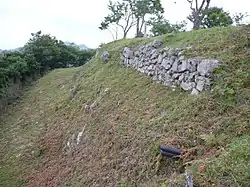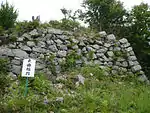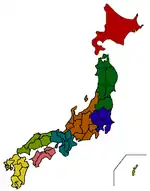Kuroi Castle
Kuroi Castle (黒井城, Kuroi-jō) was a castle structure in Tanba, HyōgoHyōgo Prefecture, Japan.[1] Famous as the birthplace of Lady Kasuga, the wet nurse of Tokugawa Iemitsu.[2]
| Kuroi Castle | |
|---|---|
黒井城 | |
| Hyōgo Prefecture, Japan | |
 Stone wall of Honmaru Base | |
| Type | Mountaintop style castle |
| Site information | |
| Owner | Akai clan, Akechi clan |
| Condition | ruins |
| Site history | |
| Built | 14c |
| Built by | Akamatsu Norisada |
| Materials | Stone walls |
| Demolished | 1584 |
| Events | Battle of Kuroi Castle |
| Garrison information | |
| Past commanders | Akai Naomasa, Saitō Toshimitsu, Horio Yoshiharu |
The castle was built by Akamatsu Norisada and later red demon(oni) of tanba Akai Naomasa and Akechi Mitsuhide`s general Saitō Toshimitsu improved the defences of the castle.[1]
In 1575, Oda Nobunaga`s vassal Akechi Mitsuhide attempted to seize the castle but failed due to Hatano Hideharu`s relief force arrived from Yakami Castle and attacked the backside of Akechi's army.[1]
In 1577, Kuroi Castle was attacked by Akechi Mitsuhide's army again. This time the castle was isolated therefore Akai clan surrendered in 1579.[2] After the fall of the castle Mitsuhide placed Saitō Toshimitsu as a castle commander.[3][4]
It has been said that Lady Kasuga was born in the castle in 1579.[2][4]
After the Battle of Yamazaki in 1582, Toyotomi Hideyoshi placed Horio Yoshiharu as a new castle commander.[1] Kuroi castle is now only ruins, on the present day site, just some Stone walls and earthworks. The castle was listed as one of the Continued Top 100 Japanese Castles in 2017.[5]
Gallery
 Stone wall of a Yagura Tower
Stone wall of a Yagura Tower Ninomaru Base
Ninomaru Base Gate of Honmaru Base
Gate of Honmaru Base View from Honmaru Base
View from Honmaru Base Kozenji Temple (Former residence of Saitō Toshimitsu)
Kozenji Temple (Former residence of Saitō Toshimitsu)
References
- "黒井城" (in Japanese). Tanba city official. Retrieved 25 July 2019.
- "黒井城" (in Japanese). 攻城団. Retrieved 25 July 2019.
- "黒井城" (in Japanese). 城旅. Retrieved 25 July 2019.
- "【続日本100名城・黒井城編】明智光秀を苦しめた「丹波の赤鬼」が守る山地の要塞" (in Japanese). 城びと. Retrieved 25 July 2019.
- "続日本100名城" (in Japanese). 日本城郭協会. Retrieved 25 July 2019.
